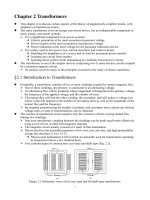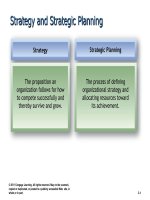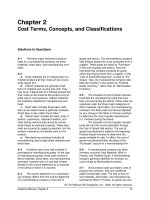Kendall7E ch02
Bạn đang xem bản rút gọn của tài liệu. Xem và tải ngay bản đầy đủ của tài liệu tại đây (1.51 MB, 53 trang )
Understanding
Organizational Style and
Its Impact on
Information Systems
Systems Analysis and Design,
7e
Kendall & Kendall
©2008 Pearson Prentice Hall
2
Learning Objectives
• Understand that organizations and their
members are systems and that analysts
need to take a systems perspective
• Depict systems graphically using contextlevel data flow diagrams, and entityrelationship models, use cases and use
case scenarios
• Recognize that different levels of
management require different systems
• Comprehend that organizational culture
impacts the design of information systems
Kendall & Kendall
2-2
Three Main Forces Interacting
to Shape Organizations
• Levels of management
• Design of organizations
• Organizational cultures
Kendall & Kendall
2-3
Organizations Are Composed
of Interrelated Subsystems
• Influenced by levels of management
decision makers that cut horizontally
across the organizational system
• Operations
• Middle management
• Strategic management
• Influenced by organizational cultures
and subcultures
Kendall & Kendall
2-4
Major Topics
• Organizations as systems
• Depicting systems graphically
• Data flow diagram
• Entity-relationship model
• Use case modeling
• Levels of management
• Organizational culture
Kendall & Kendall
2-5
Organizations As Systems
• Conceptualized as systems designed
to accomplish predetermined goals
and objectives
• Composed of smaller, interrelated
systems serving specialized functions
• Specialized functions are
reintegrated to form an effective
organizational whole
Kendall & Kendall
2-6
Interrelatedness and
Independence of Systems
• All systems and subsystems are
interrelated and interdependent
• All systems process inputs from their
environments
• All systems are contained by boundaries
separating them from their environments
• System feedback for planning and control
• An ideal system self-corrects or selfregulates itself
Kendall & Kendall
2-7
Figure 2.1 System outputs serve as
feedback that compares performance with
goals
Kendall & Kendall
2-8
Organizational
Environments
• Community
• Physical location
• Demographic profile (education, income)
• Economic
• Market factors
• Competition
• Political
• State and local government
Kendall & Kendall
2-9
Openness and Closedness
• Open
• Free flow of information
• Output from one system becomes
input to another
• Closed
• Restricted access to information
• Limited by numerous rules
• Information only on a “need to know”
basis
Kendall & Kendall
2-10
Virtual Organizations and
Virtual Teams
• A virtual organization has parts of
the organization in different
physical locations
• Computer networks and
communications technology are
used to bring virtual teams
together to work on projects
Kendall & Kendall
2-11
Benefits of Virtual
Organizations and Teams
• Possibility of reducing costs of
physical facilities
• More rapid response to customer
needs
• Helping virtual employees to fulfill
their familial obligations to children
or aging parents
Kendall & Kendall
2-12
Taking a Systems
Perspective
• Allows system analyst to understand
businesses before they begin their tasks
• It is important that members of
subsystems realize that they are
interrelated with other subsystems
• Problems occur when each manager
thinks that his/her department is the
most important
• Bigger problems may occur when that
manager rises through the ranks
Kendall & Kendall
2-13
Taking a Systems
Perspective
Kendall & Kendall
2-14
Taking a Systems
Perspective
Kendall & Kendall
2-15
Enterprise Resource
Planning
• Enterprise Resource Planning (ERP)
describes an integrated
organizational information system
• Software that helps the flow of
information between the functional
areas within the organization
Kendall & Kendall
2-16
Depicting Systems
Graphically
• Context-level data flow diagrams
• Entity-relationship model
• Use Case Modeling
Kendall & Kendall
2-17
Context-Level Data Flow
Diagrams
• Focus is on the data flowing into
and out of the system and the
processing of the data
Kendall & Kendall
2-18
Figure 2.4 The basic
symbols of a data flow
diagram
Kendall & Kendall
2-19
Airline Reservation System
Kendall & Kendall
2-20









